In this French “decksploration” board game, up to four players take roles as time travelers working together to resolve anomalies in the timestream that threaten the space-time continuum.
The basic game comes with one introductory mission, “Asylum,” in which time travelers assume the identities of institutionalized mental patients in 1920s France. Other available mission/story decks include the fantasy-themed “Prophecy of Dragons” and the zombie apocalypse rescue mission “The Marcy Case.”
Gameplay involves group decisions to investigate different locations (sets of illustrated cards), confront character tests found there (dice rolls), collect new information and items (more cards), and ultimately resolve the adventure’s mystery within a specific amount of time (typically about 12 game turns).
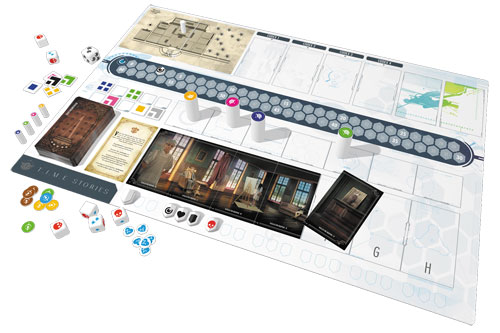
BASIC RULES OF TIME TRAVELERS (T.I.M.E AGENTS)
Each time traveler “possesses” the mind of a “receptacle,” someone who lived in the time period of the temporal anomaly. If a receptacle is killed, his or her body can be revived later.
All time travelers must stay close to each other during the mission (splitting up only within the same location), but they share a telepathic bond to communicate what they are seeing and experiencing. (Table talk is allowed, but no direct showing of cards.)
Each mission is limited to a certain duration measured in “time units.” The exact length of a time unit is not clearly defined and varies per mission. In “Asylum,” each unit seems to last about one minute.
Every move and action the group takes will cost time units, and running out of time ends the mission. However, as time travelers, failure is not an option and the mission can repeated by returning a few moments before the start of the last failed mission. (On a new run, a player may choose a different receptacle character.)
THE CARDS
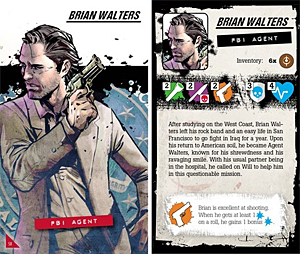 Receptacle cards are characters sheets. Such cards note how many dice a character rolls for specific types of challenges, resistance ratings, life points, starting items and special abilities.
Receptacle cards are characters sheets. Such cards note how many dice a character rolls for specific types of challenges, resistance ratings, life points, starting items and special abilities.
Characteristics vary from adventure to adventure. For example, in “Asylum” the characters have ratings in Deftness, Glibness and Combat Strength, while in “The Marcy Case” characteristics include Search, Ranged Combat and Close Combat.
In all settings, the number on the blue skull symbol rates a character’s Resistance (akin to “armor class”), and the number on the blue heart icon determines the character’s starting number of Life Points (akin to “hit points”).
Item cards are for tools and discovered information. Some items may be shared among the whole group, while others must be in the possession of only one character at a time. Item cards also include updated map pieces that reveal new locations to explore on the game board’s “plan” map.
Mission cards are locations. Within each location are three to seven illustrated “spaces” (labelled A, B, C, etc.) in which a character may interact with the scene. Some spaces may be off-limits until the appropriate matching “state token” square has been unlocked from another space, a previous location or an item card.
 * A red “minus” symbol on the back means the card cannot come into play until some other rule says it can.
* A red “minus” symbol on the back means the card cannot come into play until some other rule says it can.
 * A purple “trashcan” symbol on the back means if no character enters this location space card when the location is first entered by the group, the card is discarded from play.
* A purple “trashcan” symbol on the back means if no character enters this location space card when the location is first entered by the group, the card is discarded from play.
 * A yellow “exclamation point” symbol on the back means at least one character MUST enter this location space card when the location is first entered by the group.
* A yellow “exclamation point” symbol on the back means at least one character MUST enter this location space card when the location is first entered by the group.
OTHER PLAYING PIECES
 Pawns are used to show where characters are within one location. Players may only read mission location cards for spaces in which they have their own pawn. Any number of pawns may occupy the same space within one location, and some spaces will have no pawns, but the group must move together to the same overall location. A separate small pawn is used to show which location the group currently is at on the game board’s “plan” map.
Pawns are used to show where characters are within one location. Players may only read mission location cards for spaces in which they have their own pawn. Any number of pawns may occupy the same space within one location, and some spaces will have no pawns, but the group must move together to the same overall location. A separate small pawn is used to show which location the group currently is at on the game board’s “plan” map.
 Resource tokens are colored discs used track minor “consumable” items characters may carry during the mission. For example, brown resource discs may represent ammunition for a weapon, yellow resource discs may represent gold pieces, and so forth.
Resource tokens are colored discs used track minor “consumable” items characters may carry during the mission. For example, brown resource discs may represent ammunition for a weapon, yellow resource discs may represent gold pieces, and so forth.
 Life points are discs with blue hearts used roughly the same as “hit points” found in other role-playing games. They can be lost due to damage when the total number of red skulls shown on cards and dice in a test challenge outnumber a character’s Resistance value (the blue skull number on the receptacle card). When all Life Points are gone, that character dies — but can come back if more than 7 time units remain on the mission.
Life points are discs with blue hearts used roughly the same as “hit points” found in other role-playing games. They can be lost due to damage when the total number of red skulls shown on cards and dice in a test challenge outnumber a character’s Resistance value (the blue skull number on the receptacle card). When all Life Points are gone, that character dies — but can come back if more than 7 time units remain on the mission.
 State tokens are colored squares that track achievements needed to enter specially marked spaces within a location. These “sealed” location cards may not be looked at by players until the appropriate state token has been made active.
State tokens are colored squares that track achievements needed to enter specially marked spaces within a location. These “sealed” location cards may not be looked at by players until the appropriate state token has been made active.
SPENDING TIME UNITS
 Typically a mission’s first run — the initial attempt to fix the anomaly — starts with 25 time units, which works out to about 10 to 12 game turns. Repeated loops through the mission may start with more or less time.
Typically a mission’s first run — the initial attempt to fix the anomaly — starts with 25 time units, which works out to about 10 to 12 game turns. Repeated loops through the mission may start with more or less time.
 The “time captain die” is a six-sided cube with one to three time unit symbols on each face. If using a regular six-sided die…
The “time captain die” is a six-sided cube with one to three time unit symbols on each face. If using a regular six-sided die…
* Roll of 1 = 1 time unit
* Roll of 2, 3, 4 or 5 = 2 time units
* Roll of 6 = 3 time units
It costs one roll of the “time captain die” to move the group from a location with a name written in black letters and then, if desired, split up among spaces in a new location to read those mission cards. (This roll will result in a cost of 1 to 3 time units.)
It costs one roll of the “time captain die” plus 2 time units to move the group from a location with a name written in red letters and then, if desired, split up among spaces in a new location to read those mission cards. (This roll will result in a cost of 3 to 5 time units.)
LOCATIONS & SPACES
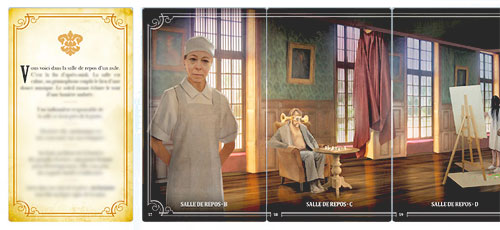
The mission deck includes several known and not-yet-known locations, each set made up of three to seven cards (one intro “A” card and several “B to G” spaces).
It costs nothing to look at a location’s pictures and read the “A” card description. The group may decide whether or not to enter the location unless the “A” card says otherwise.
If entering after reading card “A,” the group may split up to different spaces within that location. Players put their character pawns on spaces, pick up the card for their space and read to themselves what happens next. (More than one character pawn may land on the same space, and every player with a character in that space reads the appropriate card.)
Spending another turn in a location to interact with more space cards, or finish an incomplete challenge previously revealed in a space, costs the group 1 time unit regardless of how many characters are in the group or what those characters are doing.
ACTIONS ALLOWED AT A LOCATION
* Make a characteristic roll to overcome a challenge (persuade an NPC, fight a enemy, open a lock, or so forth).
* Move characters to different spaces in a location (often to help repeat a characteristic roll by working together and combining stats for more dice on a test).
* Do nothing and hold position.
(Remember when actions happen, the GROUP spends 1 time unit at the location, not 1 unit per character.)
TESTS, CHALLENGES AND DICE ROLLS

Shield tokens are used to measure a challenge’s difficulty and potential risk. Removing shields by rolling blue “burst” symbols on dice keeps track of characters’ progress toward success in a test.
Plain shields on the challenge represent the initial difficulty or resistance of a space’s test.
Red skull shields on the test represent the danger involved with challenge, possibly causing harm to those characters involved. On a “receptacle” character’s card, the blue skull number is Resistance against harmful red skulls, while the blue heart number is starting Life Points to avoid death. The red skull shields only come into play as a threat to characters during an action if one of more red skulls are rolled on the action dice, and the threat only applies to those characters in that space (not elsewhere in the location).
Black heart shields represent the automatic loss of Life Points following a dice roll, even if no red skulls are rolled on the action dice.
Time unit shields represent the automatic loss of Time Units involved with challenge following the dice roll.
 A red lock symbol on a test means the challenge cannot be avoided and must be resolved until the test is complete or all characters in that space have been killed.
A red lock symbol on a test means the challenge cannot be avoided and must be resolved until the test is complete or all characters in that space have been killed.
TO DO A TEST…
 Total the appropriate characteristic values from all characters in the space to determine how many action dice should be rolled. Each die has sides showing blank (no results), one blue hit (minor success), two blue hits (major success) and red skulls (danger).
Total the appropriate characteristic values from all characters in the space to determine how many action dice should be rolled. Each die has sides showing blank (no results), one blue hit (minor success), two blue hits (major success) and red skulls (danger).
If using regular six-sided dice…
* each roll of 1 or 2 = red skull
* each roll of 3 = blank
* each roll of 4 or 5 = one blue hit
* each roll of 6 = two blue hits

Each blue hit rolled by the players (up to two per die) removes one shield from the challenge. Types of shields are removed following the order illustrated from left to right on each challenge test card. When all challenge shields have been removed, the test is successful. (Player might be allowed to abandon a test before being successful, but doing so resets all shields.)

Riposte Rule: Each red skull rolled by the players indicates danger and potential harm in the effort. After a roll, add up the number of rolled red skull dice plus the red skull shields left in the challenge. (If no red skull results came up on the dice, then the threat of this “riposte” damage is ignored.)
 * If a character’s Resistance value (blue skull shield) is equal to or greater than the total number of red skulls shown after the dice roll, nothing bad happens (no damage, riposte was resisted or blocked).
* If a character’s Resistance value (blue skull shield) is equal to or greater than the total number of red skulls shown after the dice roll, nothing bad happens (no damage, riposte was resisted or blocked).
* If a character’s Resistance value (blue skull shield) is less than the total number of red skulls shown after the dice roll, that character loses 1 Life Point.

If black heart shields or time unit shields are left in the challenge after a dice roll, lose that many Life Points per character involved in the test or overall mission time units.
Black shield tokens may invoke special rules on a case-by-case basis shown on location cards.
After a dice roll, if a challenge still has shields left, the characters may stay and continue the test — costing 1 time unit for the group, but in doing so other characters may move to the space and join the effort to beat the test.
 If a red lock symbol is on the test, the characters in that space MUST stay until successful or killed.
If a red lock symbol is on the test, the characters in that space MUST stay until successful or killed.
As soon as a test’s last shield is removed, the challenge is immediately and successfully completed.
Example Of Time, Locations & Actions
The group leaves a forest to explore a cave location shown on the “plan” map. The “time captain die” is rolled, showing the trip cost 2 time units. Once at the cave and card “A” is read, three characters settle into space “B” and the fourth character goes to check out space “D.”
Players of the first three characters read the space “B” card, but the fourth player looks at the space “D” card and discovers his character is now in a locked test for combat against a monster (four blank shields, two red skull shields = total of six hits needed to win the test).
This fourth character has a Combat characteristic of 3, Resistance 2 and 3 Life Points. His characteristic gives him 3 action dice to roll, scoring two blue bursts (one-third the total needed) and two red skulls (increasing exposure to danger)…

The monster is reduced to two blank shields and two red skulls. However, since the number of red skulls shown on cards and dice results is greater than the character’s Resistance (4 red skulls versus 2 blue skulls), that character loses 1 Life Point and is left with 2 Life Points. The character cannot flee from this fight because the test shows a red lock icon.
At the end of the turn, all the players decide to gather in space D and fight the monster together, costing them 1 more time unit but allowing all the characters to roll action dice in an attempt beat the test challenge (or die trying).
CHARACTER DEATH
A character that loses all Life Points is dead (for now). Any carried items may be picked up by surviving characters in the space where the death occurred.
A killed character reappears at full health (starting Life Points) in the turn 7 time units after death. For example, a character killed when 18 time units were left on the mission returns among the group at their current location when 11 time units remain.
ITEM CARDS
Unless used as a map piece revealing new locations for the group, each item can only be used by one character at a time.
Item cards may be given to other characters in two situations:
* Both characters occupy the same space within a location. (The character just hands over the item while other events are happening there.)
* All the characters are moving to another location. (The characters exchange items while en route.)
Giving items to others does not count as its own action or cost additional time units.

Any item card that bears the T.I.M.E Agency’s logo is considered “fixed” in time and space, kept in the players’ group and not lost if the mission runs out of time units (or all the characters are killed).
REPEATING FAILED MISSIONS
If the group runs out of time units, players read the MISSION FAILED (TU) card.
If all the characters are killed, players read the MISSION FAILED card.

Items with the T.I.M.E Agency logo on them stay in play where they are. Items without this logo are returned to the Items deck.
Failed mission cards may grant the group new equipment needed to try again (ITEM cards), new information learned since the previous attempt, or additional temporal resources (a higher number of time units at the start of the mission).
Most T.I.M.E Stories scenarios seem to be written in such a way that it is impossible for the group to succeed in the mission during the first and only run, meaning success is expected in a future repeat of the time loop.
WINNING THE GAME
The time travelers’ mission is considered complete when a location or item card reads “MISSION SUCESSFUL.” Reaching that goal can take 10 turns of play or 100 turn depending on how well the players discover and use new information.
EXAMPLE OF PLAY (MINOR SPOILERS)
Here’s an example of play using the “Asylum” adventure mission that comes with the T.I.M.E Stories basic game. Two of the four players have chosen to “possess” the characters of Marie Bertholet and Madeleine du Tilleul, shown here:
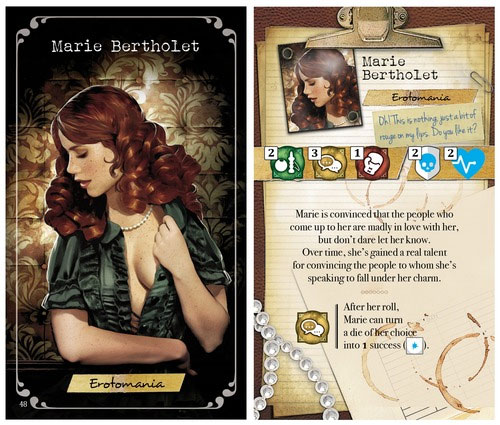
For overcoming challenges, Marie gets 2 action dice for Deftness tests, 3 dice for Glibness tests, and 1 die for Combat tests. (Her special ability guarantees she’ll always get at least one blue hit success result on Glibness tests.) If confronted by a dangerous test (marked by red skull shields in her space), her Resistance of 2 means she escapes harm if 2 or less red skulls appear on dice and sheilds. If 3 red skulls show up after the action dice are rolled, Marie will lose 1 of her 2 Life Points. If Marie loses another Life Point before finding a way to recover from this damage, she dies.
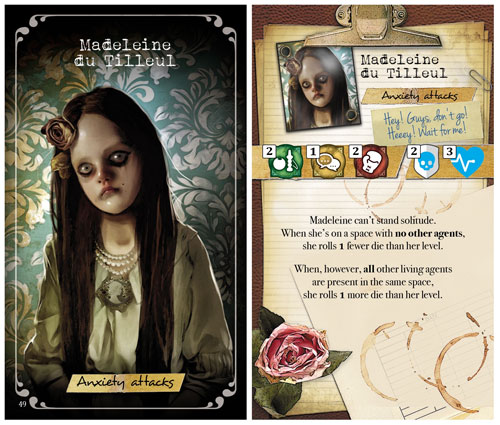
Madeleine gets 2 action dice for Deftness tests, 1 die for Glibness tests, and 2 dice for Combat tests — unless she is alone in a space, in which case she gets 1 Deftness, no Glibness and 1 Combat die. If all other characters share her space, she gets 3 dice for Deftness, 2 dice for Glibness and 3 dice for Combat. Madeleine has Resistance 2 against red skulls, and starts with 3 Life Points.
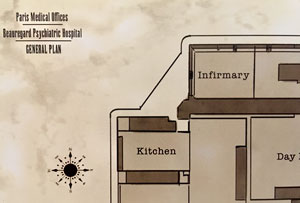
After their first turn at 25 time units left, the group of players decide to leave the institution’s Day Room and next go to the Kitchen location. A roll of the time captain die results in 2 time units, so the tracker token on the game board is moved from 25 to 23. (To the characters, the trip down the hall and around the corner took about two minutes.)
Once at the Kitchen location, one player reads card “A” aloud and everyone looks at the series of pictures making up the location’s scene (in this case, three cards with illustrations). Players then decide which spaces their characters interact with. The players of Marie Bertholet and Madeleine du Tilleul decide they should go talk to the cook and place their pawns above the card for space “B”.
After all character pawns have been placed on spaces, the Marie and Madeleine players pick up card “B,” flip is over and read to themselves what happens next to them. The other two players read to themselves the card descriptions for the spaces where their characters went.
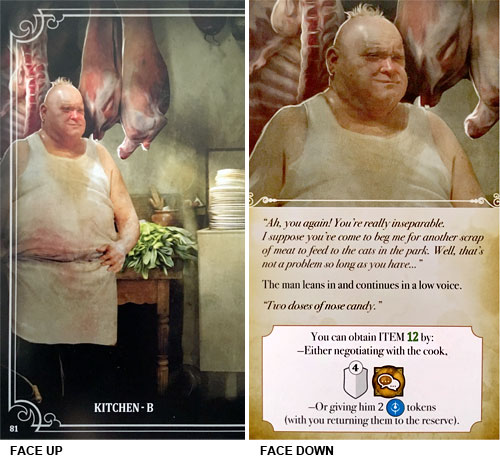
“Ah! You again! You’re really inseparable. I suppose you’ve come to beg me for another scrap of meat to feed the the cats in the park. Well, that’s not a problem so long as you have…”
The man leans in and continues in a low voice.
“Two does of nose candy.”
You can obtain ITEM 12 by:
* Either negotiating with the cook (4 blank shields using character’s Glibness characteristics for action dice),
* OR giving him 2 blue resource tokens (representing cocaine in the “Asylum” adventure) with you returning them to the reserve (game box storage).
Since neither Marie Bertholet nor Madeleine du Tilleul have any cocaine with them, they decide to try to win a Glibness test. Acting together, Marie and Madeleine have a combined total of Glibness 4, so four action dice are rolled and get this result:

However, because Marie Bertholet has a special ability to turn any one action die rolled for Glibness into one blue hit instead, the roll is changed to this result:

Four blue hits eliminate all four shields shown on the space “B” card’s characteristics test. (The cook is swayed by Marie’s flirtatious nature and surrenders to her charms without demanding the illicit drug in exchange.)
Either player for Marie or Madeleine now gets the card for ITEM 12, holding it until used or given to another player’s character:
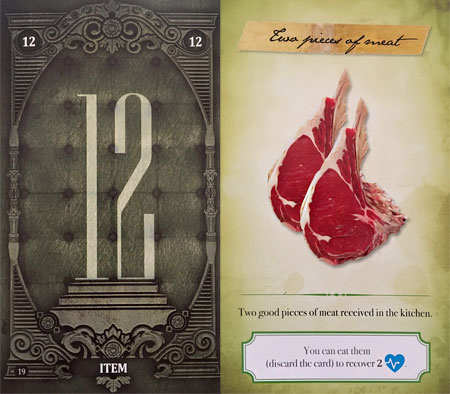
The group is now free to regroup in another Kitchen location space at a cost of 1 time unit, or travel to a different location on the plan map at a cost of 1 to 3 time units (based on the roll of the time captain die).